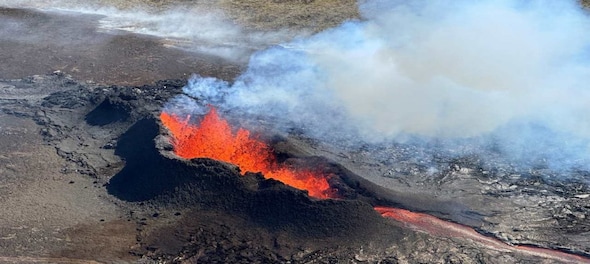
Iceland's primary tourist attraction, the Blue Lagoon, is set to temporarily close for at least a week due to the increasing risk of an eruption caused by an underground magma intrusion located a few hundred meters away from the popular geothermal seawater spa.
In a statement issued on Thursday, the spa cited concerns about the "interruption in guest experience" and the "strain on staff" as the primary reasons for the temporary closure. As of now, there are no visible signs of an imminent eruption, clarified Benedikt Ofeigsson, a geophysicist at Iceland's Met Office.
The magma is steadily accumulating in a horizontal sill at a depth of approximately 5 km and seismic activity is expected to persist, according to the Met Office. The affected area is roughly 40 km from the capital and in close proximity to Grindavik, a fishing town with around 3,600 residents. Furthermore, an eruption at this site could pose a threat to a power plant that supplies heat to 30,000 inhabitants on the Reykjanes peninsula.
Residents of a fishing town in southwestern Iceland left their homes Saturday after increasing concern about a potential volcanic eruption caused civil defense authorities to declare a state of emergency in the region.
Police decided to evacuate Grindavik after recent seismic activity in the area moved south toward the town and monitoring indicated that a corridor of magma, or semi-molten rock, now extends under the community, Iceland’s Meteorological Office said. The town of 3,400 is on the Reykjanes Peninsula, about 50 kilometers (31 miles) southwest of the capital, Reykjavik.
“At this stage, it is not possible to determine exactly whether and where magma might reach the surface,” the Meteorological Office said.
Authorities also raised their aviation alert to orange, indicating an increased risk of a volcanic eruption. Volcanic eruptions pose a serious hazard to aviation because they can spew highly abrasive ash high into the atmosphere, where it can cause jet engines to fail, damage flight control systems and reduce visibility.
A major eruption in Iceland in 2010 caused widespread disruption to air travel between Europe and North America, costing airlines an estimated $3 billion as they canceled more than 100,000 flights.
The evacuation comes after the region was shaken by hundreds of small earthquakes every day for more than two weeks as scientists monitor a buildup of magma some 5 kilometers (3.1 miles) underground.
Concern about a possible eruption increased in the early hours of Thursday when a magnitude 4.8 earthquake hit the area, forcing the internationally known Blue Lagoon geothermal resort to close temporarily.
The seismic activity started in an area north of Grindavik where there is a network of 2,000-year-old craters, geology professor Pall Einarrson, told Iceland’s RUV. The magma corridor is about 10 kilometers (6.2 miles) long and spreading, he said.
“The biggest earthquakes originated there, under this old series of craters, but since then it (the magma corridor) has been getting longer, went under the urban area in Grindavík and is heading even further and towards the sea,” he said.
(With inputs from agencies)
(Edited by : Jerome Anthony)
Check out our in-depth Market Coverage, Business News & get real-time Stock Market Updates on CNBC-TV18. Also, Watch our channels CNBC-TV18, CNBC Awaaz and CNBC Bajar Live on-the-go!


BJP's Hindi heartland dominance faces test in phase 3 polls
May 2, 2024 9:14 PM
Lok Sabha Election: Re-elections at a Ajmer booth after presiding officer misplaces register of voters
May 2, 2024 4:54 PM

